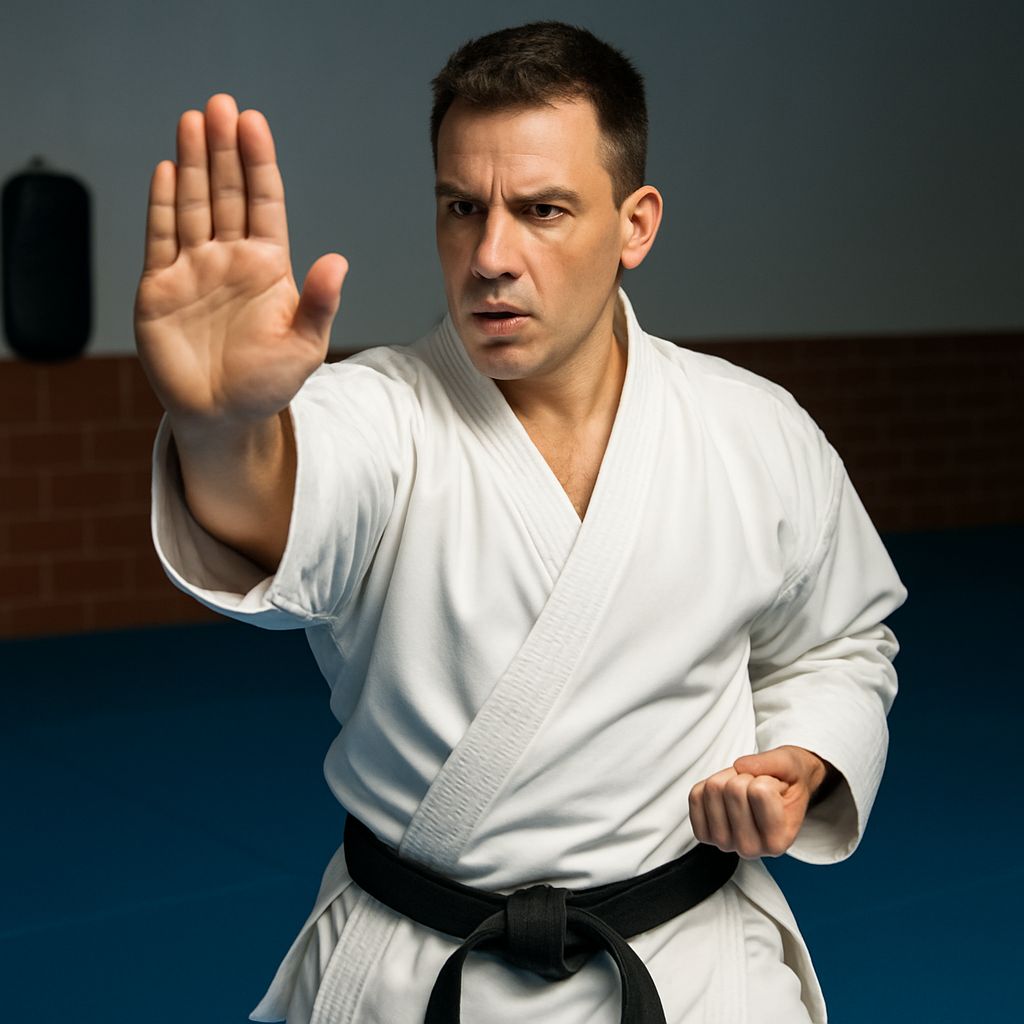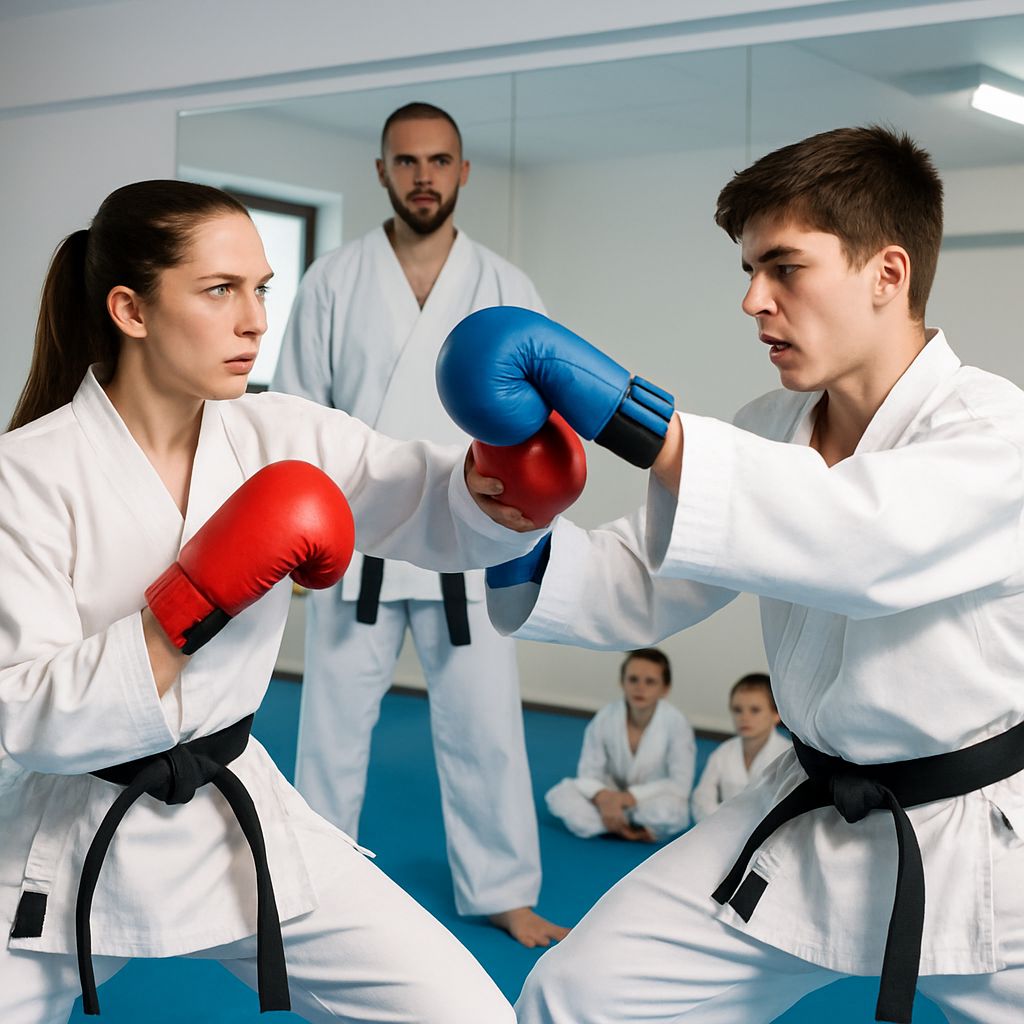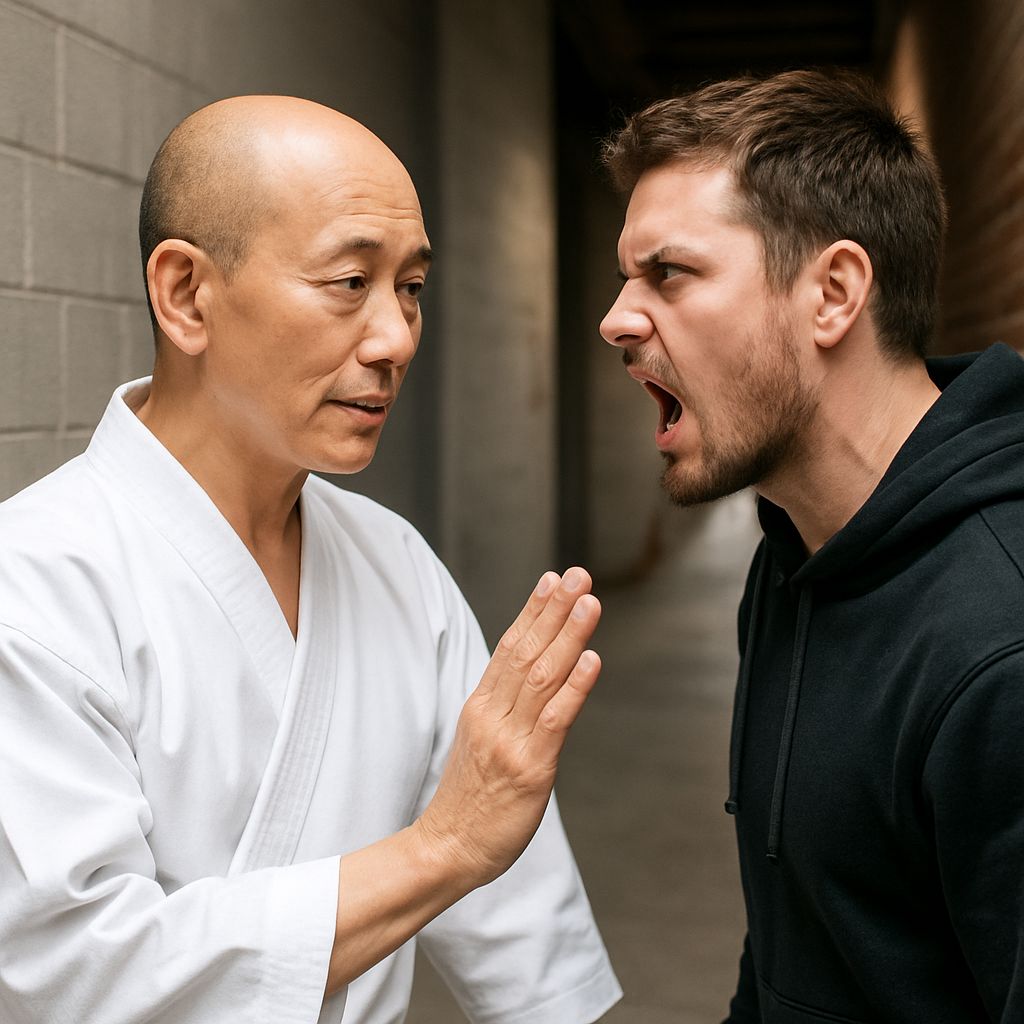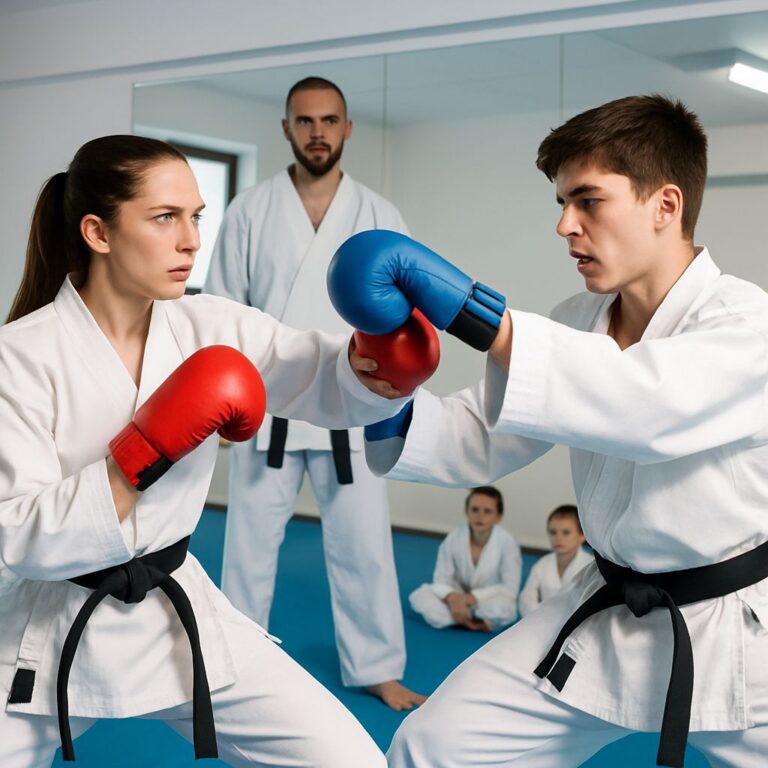Can Karate Save You in a Real-Life Fight?🥋
Ever asked yourself, “Can karate really help if someone attacks me on the street?”
Is this something you want to search the entire internet for, analyze it, and separate the fluff from facts?
✅ After analyzing everything across the internet and gathering real-world insights, the Bhussan.com team shares this friendly, helpful article, crafted just for you.
And guess what? Karate isn’t just about breaking boards—it’s about breaking away from danger safely.
1. Awareness is Your First Weapon 🧠 (Karate for Self-Defense starts here)
In karate, you’re taught to fight only when you must. But long before that… you learn how to sense trouble before it starts.
Here’s how:
-
✅ Stay alert in public places
-
✅ Read the body language of others
-
✅ Position yourself near exits
-
✅ Trust your intuition—it’s rarely wrong
Example: I once walked out of a sketchy parking lot just because something didn’t feel right. And later? Police sirens. Enough said.

When it comes to karate for self-defense, one of the most important lessons you’ll learn isn’t about fighting techniques at all. It’s about awareness—and it’s something you can apply long before any confrontation even begins.
Many people think that martial arts like karate are all about flashy punches, high kicks, and aggressive sparring. While those techniques are essential, awareness is your first line of defense. Let’s break down why it’s crucial, how to cultivate it, and why it could make all the difference when you find yourself in a dangerous situation.
Understanding Situational Awareness 🛑
Situational awareness means being fully aware of your surroundings, understanding potential threats, and recognizing when something feels “off.” In the world of karate for self-defense, this awareness allows you to respond appropriately, whether that means using self-defense techniques or, better yet, avoiding danger altogether.
A key aspect of awareness is understanding that danger doesn’t always come from the obvious sources. It’s not just about looking for attackers with knives or guns. It’s about noticing subtle cues—a person’s body language, eye contact, or the environment around you—that might indicate that something isn’t right.
🚶♀️ How Karate Enhances Your Awareness 🚶♂️
Karate trains your mind and body to stay alert, calm, and focused on what’s happening around you. Through years of practice, you learn how to tune in to the small details and anticipate what might happen next. This is critical because most violent encounters are not sudden. Often, there are signs beforehand that can help you make the right decision to avoid a physical confrontation.
When you’re practicing karate, you’re taught to keep your eyes on your opponent’s movements, watch their stance, and listen to the environment. This translates directly to real-world self-defense. You become a person who instinctively notices when someone’s walking too close behind you, when a person’s posture looks threatening, or when a group of people seems to be blocking your path.
👀 Key Points of Awareness in Karate for Self-Defense:
-
Always Scan Your Environment: When you walk into any public space, take a moment to observe your surroundings. Where are the exits? Is there an escape route if something happens? Who’s around you? Are there any signs of aggression in the people nearby?
-
Trust Your Gut: Your instincts are more powerful than you think. If something feels off, trust that feeling. Many self-defense situations are avoided simply by following that gut instinct that tells you to cross the street, leave the area, or avoid certain individuals.
-
Maintain a Safe Distance: Awareness also involves understanding how much personal space you need to stay safe. Karate teaches you to respect distance, because that’s your buffer zone. The more aware you are of how far away people are from you, the better you’ll be at defending yourself should someone attempt to close that gap.
-
Be Mindful of Your Own Body Language: Awareness isn’t just about reading others. It’s also about how you present yourself. Confident, upright posture and clear eye contact often deter potential threats. Weak body language—like slouching or looking at the ground—can make you a target. Karate helps instill the confidence you need to walk through the world with purpose and alertness.
🏃♀️ The Power of Proactive Awareness 🏃♂️
Imagine you’re walking to your car late at night. Your mind is elsewhere, and you’re not paying attention to your surroundings. Suddenly, you feel someone grab your arm from behind. You didn’t see them coming. In a split second, your body is reacting, and you’re trying to break free, but you’re at a disadvantage because you weren’t aware.
Now, imagine the same scenario—but this time, you’re practicing proactive awareness. You notice the person behind you a few paces back, walking at the same pace. You’ve already seen them and, instinctively, you’ve planned your next move. You take a different path to your car, keeping a buffer zone around you. You notice the person’s nervous glance and change direction. No confrontation, no stress, just a calm and confident exit.
This is the power of awareness. And this is what karate for self-defense gives you: the ability to see what others might miss and take the necessary steps to avoid trouble before it even begins.
⚖️ Balancing Awareness and Action ⚖️
It’s important to remember that awareness isn’t just about avoiding danger; it’s also about knowing when to act. Karate teaches you how to recognize when avoidance isn’t an option and when it’s time to defend yourself. Being aware of an approaching threat gives you the ability to act swiftly, using the self-defense techniques you’ve practiced, without hesitation.
In self-defense, hesitation can be costly. Karate ensures that you’re never caught off guard because you’ve already honed your instincts to detect danger early. When you recognize the threat, you’ll know exactly how to respond, whether it’s using a defensive block, delivering a quick strike, or making an escape.
🌟 Why Awareness Is More Than Just Self-Defense 🌟
While karate for self-defense is critical, the benefits of awareness extend beyond just protection from physical threats. Practicing awareness also:
-
Boosts mental clarity: Staying aware of your environment increases mental sharpness in all aspects of life.
-
Improves focus: The more you practice awareness in your daily life, the more you’ll enhance your overall focus and concentration in other areas, like work or study.
-
Reduces stress: Knowing that you’re in control of your surroundings leads to a sense of peace and calm.
Final Thoughts on Awareness in Karate for Self-Defense
Karate isn’t just about learning how to punch or kick—it’s about building a mindset that’s always alert, always assessing, and always prepared. When you develop situational awareness, you become empowered. You not only increase your safety, but you also gain a deeper understanding of the world around you. So, whether you’re in the dojo or on the street, awareness truly is your first weapon.
Would you like to dive deeper into other karate techniques for self-defense? Check out our next section on basic strikes that can turn the tide in dangerous situations.

2. Basic Strikes That Actually Work in Real Life🥋
In karate for self-defense, flashy kicks look cool—but simple works best when your adrenaline’s pumping.
✅ Learn these real-life strikes:
-
Palm heel to the nose 👊
-
Elbow strike to the jaw 💥
-
Low kick to the shin or knee 🦵
-
Hammerfist to the collarbone
Why it works: These targets cause pain, buy you time to escape, and don’t need crazy flexibility or years of training.
3. Karate Training Conditions You for Stress🛡️
You know what happens in real danger? You freeze… unless you’ve practiced.
That’s where karate for self-defense shines.
✅ Karate drills simulate real-life danger:
-
Aggressive sparring builds resilience
-
Loud kiai (shouts) help assert dominance
-
Partner drills mimic grabs, punches, and surprises
My story? The first time I sparred in class, I was a nervous mess. But within weeks, my confidence skyrocketed—not just in the dojo, but in life.

4. Control Your Emotions, Not Just the Fight🧘♂️
Karate for self-defense isn’t just muscle—it’s mindset.
✅ Learn to:
-
Stay calm when threatened
-
Use breathing to control adrenaline
-
Make split-second decisions under pressure
Because losing control = losing the fight.
5. Your Goal Is Escape, Not Victory🚪
Forget the Hollywood scenes—your goal is to get home safe, not win a trophy.
✅ In real karate:
-
You strike to create a chance to run
-
You NEVER “fight to the end” unless forced
-
You use the environment—doors, obstacles, even sound—to flee
This might be the most misunderstood truth in martial arts.

6. Respect and Prevention = True Strength🤝
Karate teaches you to:
-
Avoid arrogance
-
Walk away when you can
-
De-escalate with calm confidence
✅ Many fights are won before a single punch is thrown. Your tone, posture, and eye contact speak louder than fists.
Fact: Most real-world karate black belts have never used it violently—and that’s a win.

7. Empowerment: Feel Safe Walking Alone at Night💪
The #1 benefit of karate for self-defense?
Confidence. Not cocky swagger, but calm readiness.
✅ You’ll notice:
-
You walk taller
-
You breathe easier in dark streets
-
You don’t panic when someone bumps into you
Karate changes your body, but more importantly, your brain.

Pros and Cons Table: Karate for Self-Defense
| Pros | Cons |
|---|---|
| Builds real confidence | Takes time to master |
| Easy to learn basics | Not always useful in ground fights |
| Improves awareness and control | Must be paired with an escape strategy |
| Develops both body & mind | Needs consistent training |
30+ Frequently Asked Questions: Karate for Self-Defense❓
1. Can karate be used effectively in real street fights?
Yes, absolutely—but it depends on how you’re trained. Karate teaches awareness, striking, blocking, and escaping techniques that are practical in real scenarios.
2. What is the best karate move for self-defense?
There’s no “best,” but palm heel strikes, low kicks, and elbow hits are among the most effective and easy-to-use under pressure.
3. Is karate better than other martial arts for self-defense?
It depends. Karate is great for striking and discipline, but it should ideally be combined with situational training or grappling for a well-rounded defense.
4. How long does it take to learn karate for self-defense?
You can start learning practical moves within a few weeks, but solid confidence takes at least 6 months of regular training.
5. Is karate useful for women’s self-defense?
Absolutely. Karate boosts confidence, teaches quick escape moves, and builds the mindset to resist or escape threats.
6. Can children use karate to defend themselves?
Yes, karate teaches kids how to avoid danger, alert adults, and use age-appropriate techniques to escape bullying or threats.
7. Does karate teach you how to disarm a weapon attack?
Not typically. Most karate systems focus on unarmed defense. Advanced dojos may include weapon defense, but it’s rare.
8. What belt level do you need before karate is effective?
Even white belts learn useful techniques. You don’t need a black belt to defend yourself—you just need consistent practice.
9. What part of the body should I aim for in a real fight?
Go for soft targets like the nose, throat, groin, knees, or solar plexus. These areas are most effective for disabling an attacker.
10. How does karate improve situational awareness?
Karate teaches you to read your environment, recognize threats early, and avoid dangerous confrontations altogether.
11. Is sparring important for self-defense training?
Yes! Sparring helps you handle pressure, think fast, and move naturally during an actual confrontation.
12. Does karate teach you how to escape holds or grabs?
Yes, most styles include grab defenses, wrist escapes, and clinch techniques—especially in higher belts.
13. Are all karate schools focused on real-world self-defense?
No. Some schools focus more on sport or tradition. Look for dojos that emphasize “practical karate” or self-defense drills.
14. Can I learn karate online for self-defense?
You can learn the basics, but physical training with an instructor is essential to develop proper form and reflexes.
15. What’s the difference between karate and Krav Maga for self-defense?
Krav Maga is more direct and military-based, while karate emphasizes discipline, form, and philosophy. Both can be effective when trained properly.
16. Will karate make me more confident in dangerous situations?
Yes! Karate trains your body and mind to handle fear, stay calm, and make decisions quickly under stress.
17. Do I need to be physically strong to use karate?
Nope! Karate uses leverage, technique, and timing more than brute strength. Even smaller people can defend themselves effectively.
18. What’s the role of kata (forms) in self-defense?
Kata teaches patterns and muscle memory. Some argue it’s outdated, but many moves in kata have real-life self-defense applications.
19. Can karate help in domestic violence or abuse situations?
Yes. It helps develop escape skills, mental strength, and confidence, plus the awareness to seek help and take action.
20. How can I practice karate self-defense at home?
You can shadowbox, practice strikes on a punching bag, follow YouTube drills, and rehearse escape moves with a partner.
21. Is karate allowed as self-defense in legal situations?
Yes, as long as the force used is proportional. Most countries support using reasonable self-defense when threatened.
22. Does karate include ground defense or grappling?
Not much. Karate focuses on stand-up techniques. For ground defense, combining with jiu-jitsu is highly recommended.
23. What’s the best age to start learning karate for self-defense?
Any age! Kids as young as 4 and adults over 60 can start training. It’s never too late to learn to protect yourself.
24. Will karate help me stay calm in emergencies?
Yes. The breathing techniques, repetition, and mental discipline you learn in karate directly translate to crisis management.
25. How often should I train to stay ready for self-defense?
At least 2–3 times a week to build and retain your muscle memory and reflexes.
26. Does karate improve reaction time?
Yes. Drills, sparring, and repetition improve your reflexes and help you react faster under pressure.
27. What should I yell during a self-defense move?
“Kiai!” is traditional in karate. It’s a sharp, focused shout that startles your attacker and powers up your strike.
28. Can karate prevent me from being bullied?
Yes—especially the confidence and body language you build. Bullies often avoid people who project strength.
29. How does karate help with fear or panic?
Karate teaches controlled breathing and mental focus, which helps reduce fear and improve decision-making in real danger.
30. What are common myths about karate and self-defense?
-
Myth: You need a black belt to defend yourself ❌
-
Myth: Karate is only for kids ❌
-
Myth: It’s not effective on the streets ❌
-
Truth: It’s powerful if trained properly ✅
31. Can I defend against multiple attackers with karate?
Karate helps—but it’s best to focus on escaping rather than fighting everyone. Create openings, don’t play hero.
32. Do I need weapons training with karate?
Not necessarily. Traditional karate includes some weapons (like nunchaku or bo), but for self-defense, your body is your best weapon.
33. Can karate help protect others too?
Yes! Once you’re confident in defending yourself, you’re better equipped to help others safely escape or de-escalate.
Conclusion
Karate for self-defense isn’t about violence. It’s about smart, effective action when it matters most. It’s about keeping yourself safe, not proving a point.
Start slow. Train often. Stay aware. And never forget—real strength is knowing when to fight… and when to walk away.
external link: The_Karate_Kid_(2010_film)

